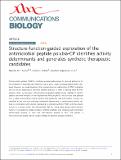Structure-function-guided exploration of the antimicrobial peptide polybia-CP identifies activity determinants and generates synthetic therapeutic candidates
Author(s)
Torres, Marcelo DT; Pedron, Cibele N; Higashikuni, Yasutomi; Kramer, Robin M; Cardoso, Marlon H; Oshiro, Karen GN; Franco, Octávio L; Silva Junior, Pedro I; Silva, Fernanda D; Oliveira Junior, Vani X; Lu, Timothy K; de la Fuente-Nunez, Cesar; ... Show more Show less
DownloadPublished version (2.665Mb)
Terms of use
Metadata
Show full item recordAbstract
© 2018, The Author(s). Antimicrobial peptides (AMPs) constitute promising alternatives to classical antibiotics for the treatment of drug-resistant infections, which are a rapidly emerging global health challenge. However, our understanding of the structure-function relationships of AMPs is limited, and we are just beginning to rationally engineer peptides in order to develop them as therapeutics. Here, we leverage a physicochemical-guided peptide design strategy to identify specific functional hotspots in the wasp-derived AMP polybia-CP and turn this toxic peptide into a viable antimicrobial. Helical fraction, hydrophobicity, and hydrophobic moment are identified as key structural and physicochemical determinants of antimicrobial activity, utilized in combination with rational engineering to generate synthetic AMPs with therapeutic activity in a mouse model. We demonstrate that, by tuning these physicochemical parameters, it is possible to design nontoxic synthetic peptides with enhanced sub-micromolar antimicrobial potency in vitro and anti-infective activity in vivo. We present a physicochemical-guided rational design strategy to generate peptide antibiotics.
Date issued
2018Department
Massachusetts Institute of Technology. Synthetic Biology Center; Massachusetts Institute of Technology. Center for Microbiome Informatics and Therapeutics; Massachusetts Institute of Technology. Research Laboratory of Electronics; Massachusetts Institute of Technology. Department of Biological Engineering; Massachusetts Institute of Technology. Department of Electrical Engineering and Computer Science; Massachusetts Institute of Technology. Division of Comparative MedicineJournal
Communications Biology
Publisher
Springer Nature